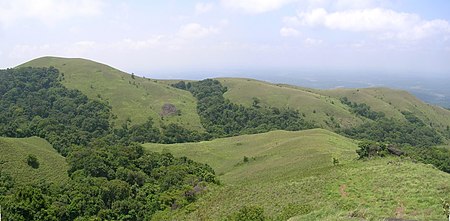Shola Forest is found in the Western Ghats in southern India. The Shola Forest is a unique ecosystem that showcases the remarkable biodiversity of the region. It shows a high degree of endemism and it is sensitive towards climate change. It is high altitude montane forest. The word “Shola” is derived from the Tamil language, meaning “tropical rainforest”.

Table of Contents
Shola Forest as Biodiversity Hotspot
Shola Forest is recognized as one of the world’s biodiversity hotspots. It is home to various plant and animal species, many of which are endemic to the region. The forest acts as a habitat for several endangered species, including the Nilgiri tahr, Lion-tailed macaque, and Nilgiri langur.
The Shola Forest boasts a rich tapestry of flora. The stunted evergreen trees create a canopy that supports a variety of mosses, lichens, and orchids. Some of the notable tree species found here include Rhododendron, Magnolia, and Cinnamon. The forest is known for wide variety of fauna like the Nilgiri wood pigeon, Nilgiri flycatcher, and Black-and-orange flycatcher. The forest is also home to mammals such as the Indian giant squirrel, leopard, and Malabar civet.
Ecological Significance of Shola Forest
It plays a crucial role in maintaining the ecological balance of the Western Ghats region. It acts as a natural water catchment area, supplying water to many rivers and streams that are vital for irrigation and drinking water purposes. The dense vegetation helps in soil conservation and prevents soil erosion on steep slopes.
Moreover, the forest contributes to carbon sequestration, mitigating the effects of climate change. The Shola Forest acts as a carbon sink, absorbing carbon dioxide from the atmosphere and storing it in its vegetation and soil.
Conservation Challenges
Despite its ecological significance, the Forest faces numerous conservation challenges. Encroachment, illegal logging, and conversion of land for agriculture and commercial plantations threaten the integrity of this fragile ecosystem. Climate change and invasive species also pose a risk to the unique flora and fauna of the forest.
Efforts are underway to protect and conserve the Forest. Government agencies, non-profit organizations, and local communities are working together to raise awareness about its importance and implement sustainable management practices. Initiatives include the establishment of protected areas, reforestation programs, and eco-tourism initiatives that promote responsible tourism while generating income for local communities.
Conclusion
The Shola Forest is a jewel in India’s ecological crown, captivating visitors with its ethereal beauty and rich biodiversity. As we marvel at its wonders, it is essential to recognize the need for its preservation. By protecting the Shola Forest, we not only safeguard its unique flora and fauna but also ensure the continued provision of vital ecosystem services. Let us join hands in cherishing and conserving this pristine ecosystem for future generations to cherish and enjoy.
Important Links